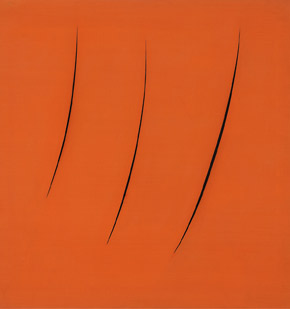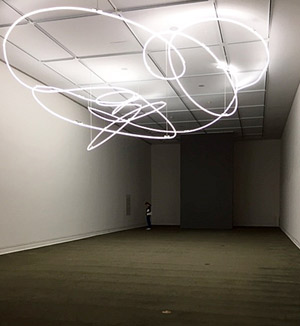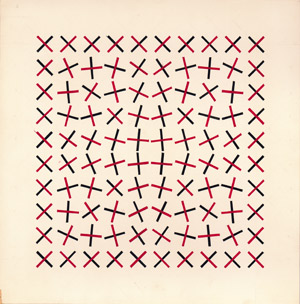Cutting Deeper
John Haberin New York City
Lucio Fontana and Julio Le Parc
Lucio Fontana had barely taken up painting when he began to leave it in shreds. So why did it take him so long—and why does it still look ever so sleek and tasteful? A retrospective beginning at the Met Breuer places Fontana's "Cuts" in context of a long career.
The postwar rebel turns out to have been a prewar stylist, in another medium altogether. The most prominent name attached to Italy's leading art movement turns out to have made his mark apart from it, before it, and on another continent. The consummate European modernist turns out to have come from Latin America, where he influenced the livelier and more minimal art of Julio Le Parc, and the master of the space between fields of color turns out to have translated that into light shows well before their time. Now if only his knife had cut deeper. As for Le Parc, he set down simple crosses on a plain square, in ten neat rows and ten neat columns. They cannot sit still all the same, and neither can anything else in "1959," a year of his life. 
Under the knife
You may not know much about Lucio Fontana, but you probably know the "Cuts." At least you know them up to a point, a knife point. Starting in 1958, he covered a canvas with a single intense color, from sky blue to rust red. And then he took a knife to it, leaving as little as a single curve running vertically at its center. Elsewhere the curves shorten and multiply, in near parallels punctuating the canvas with their rhythms. In both the wide open color field and the open air, he was living Modernism's dream of drawing in space.
It may sound impulsive, but Fontana took his time. Once he laid down color and cut right through it, he took his bare hands to the cuts to measure out their width, from thin slits to palpable voids. Then he sealed them in place, with gauze applied to the back. It became a kind of painting three times over, with the brush, the knife, and the body. It has a counterpart in another defiance of tradition that became a model for painting, Jackson Pollock and his drips. One remembers the color fields as much as the gaps, and one remembers both their lushness and their minimal means. The slits only barely depart from the vertical, like fragments of a grid, but enough to take on a shape of their own.
Subtitles bring out the dueling impulses—with the fields and the void as a negative, La Fine di Dio ("the death of god"), or a striving for the infinite, as Attese ("expectation" or "anticipations"). Each also bears the title Concetto Spaziale, or "spatial concept," and Fontana cared so much about space that he dispensed before long with color. Paintings in white on white take him closer to Minimalism, like that of Robert Ryman. Others shift to metallic paints or metal that casts its reflection on the floor. These take him closer to the sculptural and to the encroaching darkness of another European, Pierre Soulages. They can be repetitive, conservative, or simply tacky, and so were the roots of his art.
Those roots go way back. Born in 1899, Fontana took up painting only in 1951 and only to punch holes in it—lots of them. He was nearly sixty when he arrived at his "Cuts," which occupied him until his death just ten years later. So what had he been doing all that time? He was a sculptor and the son of a sculptor, who cast funeral monuments and took Lucio into the business. Before the death of god, ordinary people beings had to die.
His trajectory makes most any retrospective revisionist, and the Met obliges, big time. It also makes him a Latin American artist, with a curator, Iria Candela, from its department of Latin American art. Fontana grew up in central Argentina, nearly 200 miles from the nation's capital, and he returned in 1940 to oblige his father, an Italian immigrant, and to sit out World War II. He was hardly an indigenous American or a regionalist, like Tarsila do Amaral in Brazil, but he was every bit a part of the interchange between European and South American art, as with Lygia Clark and Grupo Frente to come. Where Grete Stern and Horacio Coppola moved between Buenos Aries and the Bauhaus, Fontana studied in Milan. He settled there for good after the war.
How Latin American was he? Revisionism has its limits. He also drew on traditional Italian majolica (or glazed earthenware) and collaborated with the ceramics workshop of a Futurist. He spent much of his thirties on the Mediterranean seacoast, where he sought the colors of the sky and sea. Back in Argentina, he taught and issued his White Manifesto, like a proper modernist, for what he called Spatialism. The museum never once mentions Italy's Arte Povera, which it became.
Beyond the threshold
Was it all, then, a prelude to his real art? The Met calls its retrospective "On the Threshold," as if the bulk of it were on the threshold of a dream. Fontana, it points out, preferred additive methods in sculpture rather than carving, working in ceramics, plaster, and tiles. And then what could be more subtractive than a knife blade or the void? I could just as soon forget the sculpture entirely. Portraits lack human character, athletes and warriors look like pale imitations of ancient Rome, their anxiety looks forced, and the clotted or encrusted surfaces look worse still, like Neo-Expressionism with neither a sense of history nor a sense of humor.
When he finally embraces Modernism on canvas, it comes as a relief. Still, the sculpture adds context and understanding, because so much else never changes. The painter of "anticipations" necessarily remains on the threshold. Even in sculpture, Fontana leaves incisions with a knife. He never abandons the additive either. He produces ceramics alongside the first "Cuts," well before Giuseppe Penone of Arte Povera in porcelain, with shapes between urns and human heads.
The first spatial concepts are additive, too. Fontana slathers on the black and white before punching holes in it, and in no time he fills the void with shards of colored glass, as glitzy as ever. Even with the "Cuts," he works with his hands much as he had in clay, and the ones in metal look more massive still.  Spatialism to him meant taking painting into the third dimension, much like sculpture. Actually, he spoke of the fourth dimension, but with little evidence of the dimension of time. Maybe he just picked up the jargon from accounts of Einstein's relativity and liked the way it sounds.
Spatialism to him meant taking painting into the third dimension, much like sculpture. Actually, he spoke of the fourth dimension, but with little evidence of the dimension of time. Maybe he just picked up the jargon from accounts of Einstein's relativity and liked the way it sounds.
Nonsense or not, the spatial concepts also carried him into installations and light shows. As early as 1951, slim neon tubes loop back and forth overhead in white, as more drawing in space. In 1964, for another Milan Triennial, points of green in neon run along the long walls of a dark alcove. They, too, function as holes, and they also form two not quite parallel curves, like cuts. Three years later, the void has become architecture, and the light has become paint. For Spatial Environment in Red Light, red neon illuminates red walls, which divide a chamber into parallel passages on the way from one entrance to another. Like the first "Cuts," it functions as color, substance, and space.
Like his paintings, it also stops short of cutting deeper. Call it a maze, if you like, but no one is in danger of getting lost. The alcove looks treacherous enough, but if you come expecting a hall of mirrors, go elsewhere. The museum also makes an odd call in placing only two of its four installations at the Met Breuer, leaving much of a floor vacant. The display of painting and sculpture is uncrowded as well. The earliest installation requires a detour to the Met, and a fourth lands a mile further up Fifth Avenue, at El Museo del Barrio.
It hammers home its claim for Latin American art, but most visitors will never make it past Madison Avenue. They can easily breeze right through the sculpture, painting, and drawing at that. Still, Fontana rewards that last journey, with a step beyond the threshold to his most luminous and imposing void. It was his last journey, too, the very year of his death. Here he and Latin American art return to white light, which almost dissolves the walls while leaving no doubt that they include, this once, unpredictable turns and dead ends. The back wall, just visible from the entrance, also has a long, deep cut.
Minimalism, modesty, and motion
A light box over the admissions desk at the Met Breuer zooms in on just a few rows by Julio Le Parc, for the twists and turns of its strokes of black and red. It packs quite a punch, for a lively introduction to a modest show. The crosses start out as multiplication signs along the edges, shifting gradually to plus signs at the center—and who knows how the sum will turn out? (Yeah, Barbie, math is hard.) The crosses seem in motion of their own accord, like elements in a photographic motion study for Harold Edgerton. Bend over backward enough, and the rows and columns may themselves seem to buckle in the space of the work or in three dimensions, and the bending will have taken you with them.
Le Parc was in motion himself. If "1959" sounds like a year in the life of a tumultuous century, it cares only about a turning point in his art, well before the larger and bolder swirls of color in his late work. Born in 1928 in Argentina, he learned from Lucio Fontana on the way toward Arte Povera that even Minimalism can be visually elegant but literally torn apart. He moved to Paris for good in 1958, where he met Victor Vasarely just as Op Art was getting off the ground. Where Bridget Riley returned illusion to fine art, Vasarely was content to be mind-bending. A year later, Le Parc sought to combine his influences, in an art of Minimalism, modesty, and motion.
The Met sticks largely to some fifty works from that one year, in gouache on cardboard, half of them a promised gift from the artist on his ninetieth birthday. Arranged in series, they break neatly in two, for Le Parc's optical present and Minimalist past. To one side lie works closest to Vasarely, filling a sheet with circles and squares to the point of chaos. To the other lie studies in motion, but rule driven and with plenty of white space. Their titles alone suggest a Minimalist's care for clarity and literalism, as with wall drawings by Sol LeWitt. Sequences of Growth and Decrease in Translational Motion, they pronounce, or Sequences of Rotation—and Le Parc delivers.
They have a light touch and a compelling logic. One work starts with a small black square, extends vertically to a line and then horizontally in search of an edge, and ends in a larger square. Another pairs complementary colors,  separated by horizontal lines, like diagrams in a textbook. (Think of color wheels and Josef Albers.) Regardless, they keep moving, and one sequence might pass for tumbling dice. They further animate the fabulous Marcel Breuer ceiling and, a feature for Kapwani Kiwanga as well at the New Museum, trapezoidal windows.
separated by horizontal lines, like diagrams in a textbook. (Think of color wheels and Josef Albers.) Regardless, they keep moving, and one sequence might pass for tumbling dice. They further animate the fabulous Marcel Breuer ceiling and, a feature for Kapwani Kiwanga as well at the New Museum, trapezoidal windows.
Still, the two sides have plenty in common. The denser works may be period pieces, like psychedelic album covers soon after, but at least one stakes its place in art history, as From a van Gogh Sky. The rules, in turn are notably open-ended—and titles also speak of the variable or post-image, as if beyond a sense of order. They led Le Parc to kinetic art, and the curator, Iria Candela throws in two examples. In one from 1966, four reflective strips wiggle against a wavy background, as Forms in Contortion over Weave. In Continual Light Cylinder, an immersive installation from 1962, one hardly knows where the motor-driven parts end and a projection begins.
The recovery of older artists can be an apology and an imperative, as with other Latin American art—or women like Carmen Herrera past age one hundred. It can also surrender to the markets, by feeding eager buyers with newly established names. Le Parc's modesty and motion attest to both the promise and the danger. More famous kinetic art, as for Jean Tinguely or Peter Fischli and David Weiss, seeks its own destruction. His does not. Yet the dice still tumble, and the crystalline forms of his projection would be at home in a show of emerging artists in new media or a Moving Image art fair today.

Lucio Fontana ran at The Met Breuer, The Metropolitan Museum of Art , and El Museo del Barrio through April 14, 2019, Julio Le Parc at the first through February 24.




